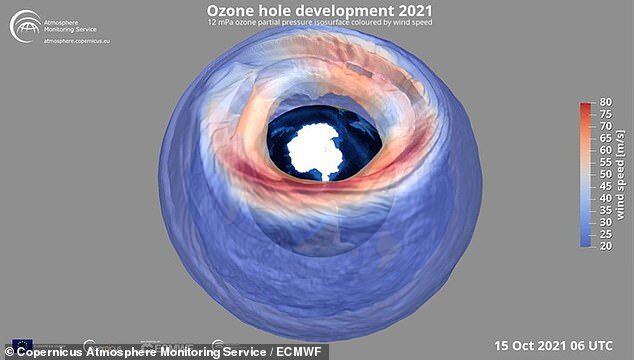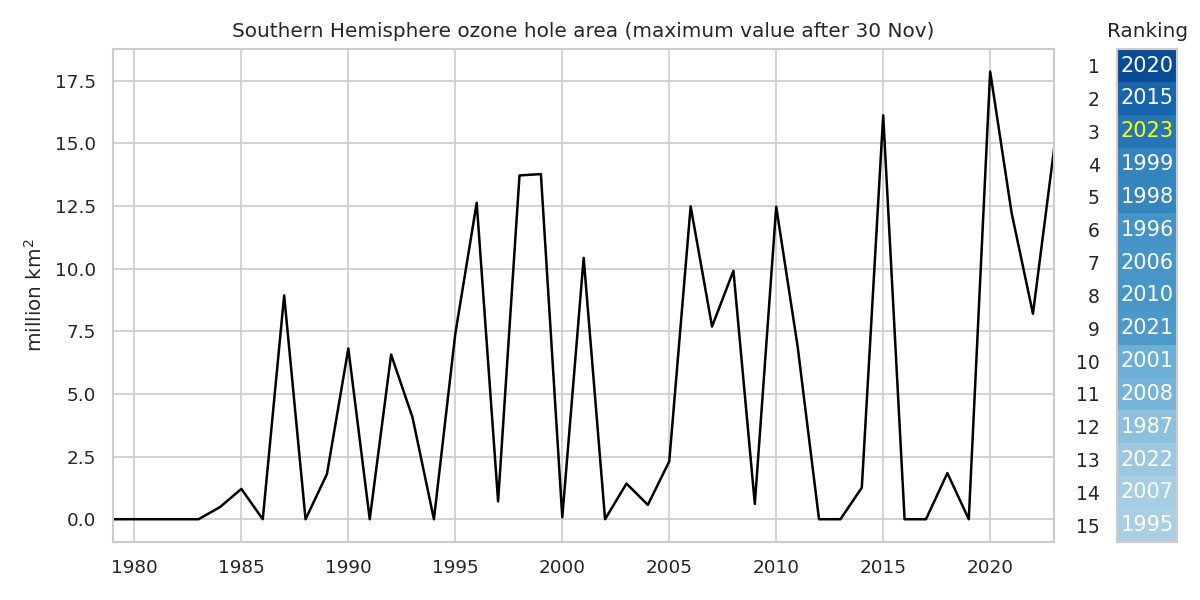The Southern Hemisphere ozone hole is unusually large, at a time when it normally reduces until its total closure, generally in December. Instead, since the end of October the ozone hole area has virtually remained unchanged, with a series of rebounds, remaining at a size of some 15 km2, to become the third largest after 30 November.
CAMS forecast indicates the ozone hole could become the largest ever observed in December. The season has been atypical since the start, as reported by CAMS, with an early increase in size to become the 6th largest on records starting in 1979. After that, the size of the ozone hole reduced quickly to come back to an average size but elongated at different moments, suggesting that the ozone hole was partly outside the 60 degrees south parallel within which the area is calculated.
The current situation is most likely linked to the dynamics of the stratosphere, and the relatively strong polar vortex, rather than chemistry, as temperatures are too warm to produce polar stratospheric clouds, that facilitate chemical ozone depletion. The ozone hole will likely persist until the breakdown of the polar vortex allowing higher ozone values from mid-latitudes to reach the southern polar stratosphere.
CAMS data has shown unusually persistent and large ozone holes during the 2020-2022 seasons, with a record late closing date in 2020 (28 December, according to CAMS data).
CAMS Director Vincent-Henri Peuch comments: "Since the signing of the Montreal Protocol, we have drastically reduced the emission of ozone depleting substances, giving space to the atmosphere to start its recovery. This is a lengthy process that involves many fluctuating factors that should be monitored to have a proper understanding of how the ozone layer is developing. The success of the Montreal Protocol is a testament to how effective actions to protect the global climate can be."
Comment: Except the ozone hole is set to be one of the largest ever recorded...
The behaviour of the Antarctic ozone hole in recent years prompts questions about the impact of global warming, which tends to cool stratospheric temperatures, but also about changes in stratospheric chemistry and dynamics. Ozone depletion is also believed to be influenced by greenhouse gas emissions, volcanic and wildfires aerosols or even changes in the solar cycle.
Comment: The solar cycle, which is also confounding propaganda science: NOAA scientists finally admit their solar cycle 25 predictions are WRONG, peak is approaching faster than expected
Gathering observations of the middle and upper stratosphere is challenging, and therefore processes are more difficult to understand in near-real time, so the large and long-lasting ozone holes in recent years, despite the reduction in emissions of ozone-depleting substances, are still a question for research.
It's also yet to be determined if the last ozone hole seasons are related to climate variability or reveal a long-term trend, delaying ozone recovery.
NASA and NOAA have declared the 2023 ozone hole as the 12th single-day record and the 16th largest averaged from September 7 to October 13. Different agencies use different methodologies to measure the ozone hole.
CAMS defines the ozone hole area where total column values are below 220 Dobson Units poleward of the 60 degrees south parallel.
According to Doctor Amy H Butler, atmospheric scientist at NOAA, stratospheric temperatures could mark daily record lows for the period of the year which would be driving this unusually large and late ozone hole. Dr. Butler suggests, like many other scientists, a possible influence of the water vapor injected into the stratosphere by the Hunga-Tonga volcano in 2022. But Dr. Butler also points to research suggesting that positive Southern Annular Mode events during austral summer can delay the "final stratospheric warming" that usually closes the ozone hole. The positive Southern Annular Mode are periods associated with higher-than-normal pressures in the areas surrounding Antarctica, and lower-than-average pressure over Antarctica.
Recent research published in Nature Communications focus on the "Potential drivers of the recent large Antarctic ozone holes." referred to the peculiar 2020-2022 ozone hole seasons, with a "re-emergence of large, long-lived ozone holes over Antarctica." according to the paper.
Comment: It's notable that it's the more recent ozone hole seasons that have been particularly 'peculiar'.
Authors investigate the monthly evolution of the ozone hole, because September is considered a more important indicator of changes in atmospheric chemistry, while October and November are thought to be dominated by stratospheric dynamics.
The research points to a slight recovery trend in September, not corresponding in October and November, that show a negative trend since 2001. Moreover, at the core of the ozone hole researchers find a significant reduction in the ozone total column from 2004 to 2022.
The ozone layer protects life on Earth from harmful ultraviolet (UV) radiation. The ozone hole also has an influence on atmospheric circulation, particularly in the Southern Hemisphere.
During austral spring the ozone depleting substances cumulated in the stratosphere interact with solar radiation and stratospheric clouds, fueled by extremely cold temperatures, creating what we now call ozone hole.
In 1987, only a few years after the confirmation of the ozone hole theory, the Montreal Protocol agreed a ban of substances responsible for ozone depletion. The agreement is considered the first global effort to protect the Planet. And while this success has avoided further damage to the ozone layer, many other factors influence ozone depletion and therefore can delay recovery.





which is why the charts conveniently start in 1980.